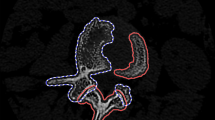Abstract
Several attempts have been made to measure geometrical torsion in adolescent idiopathic scoliosis (AIS) and quantify the three-dimensional (3D) deformation of the spine. However, these approaches are sensitive to imprecisions in the 3D modeling of the anatomy and can only capture the effect locally at the vertebrae, ignoring the global effect at the regional level and thus have never been widely used to follow the progression of a deformity. The goal of this work was to evaluate the relevance of a novel geometric torsion descriptor based on a parametric modeling of the spinal curve as a 3D index of scoliosis. First, an image-based approach anchored on prior statistical distributions is used to reconstruct the spine in 3D from biplanar X-rays. Geometric torsion measuring the twisting effect of the spine is then estimated using a technique that approximates local arc-lengths with parametric curve fitting centered at the neutral vertebra in different spinal regions. We first evaluated the method with simulated experiments, demonstrating the method’s robustness toward added noise and reconstruction inaccuracies. A pilot study involving 65 scoliotic patients exhibiting different types of deformities was also conducted. Results show the method is able to discriminate between different types of deformation based on this novel 3D index evaluated in the main thoracic and thoracolumbar/lumbar regions. This demonstrates that geometric torsion modeled by parametric spinal curve fitting is a robust tool that can be used to quantify the 3D deformation of AIS and possibly exploited as an index to classify the 3D shape.







Similar content being viewed by others
References
Cazals F, Chazal F, Lewiner T (2003) Molecular shape analysis based upon Morse–Smale complex and the Connolly function. In: Symposium on computational geometry, ACM. pp 351–360
Coeurjolly D, Svensson S (2003) Estimation of curvature along curves with application to fibres in 3D images of paper. In: Lecture notes in computer science, vol 2749. Springer, Berlin, pp 247–254
Duong L, Cheriet F, Labelle H (2006) Three-dimensional classification of spinal deformities using fuzzy clustering. Spine 31:923–930
Hierholzer E, Luxmann G (1982) Three-dimensional shape analysis of the scoliotic spine using invariant shape parameters. J Biomech 15:583–598
Hong J, Suh S, Easwar T, Modi H, Yang J, Park J (2011) Evaluation of the three-dimensional deformities in scoliosis surgery with computed tomography: efficacy and relationship with clinical outcomes. Spine 36:1259–1265
Illés T, Somoskeoy S (2013) Comparison of scoliosis measurements based on three-dimensional vertebra vectors and conventional two-dimensional measurements: advantages in evaluation of prognosis and surgical results. Eur Spine J 22:1255–1263
Kadoury S, Labelle H (2012) Classification of three-dimensional thoracic deformities in adolescent idiopathic scoliosis from a multivariate analysis. Eur Spine J 21:40–49
Kadoury S, Cheriet F, Labelle H (2009) Personalized X-ray 3D reconstruction of the scoliotic spine from statistical and image-based models. IEEE Trans Med Imaging 28:1422–1435
King H, Moe J, Bradford D et al (1983) The selection of fusion levels in thoracic idiopathic scoliosis. J Bone Jt Surg Am 65:1302–1313
Labelle H, Aubin C, Jackson R et al (2011) Seeing the Spine in 3D: how will it change what we do? J Pediatric Orthop 31:S37–S45
Lenke L, Betz R, Harms J et al (2001) Adolescent idiopathic scoliosis: a new classification to determine extent of spinal arthrodesis. J Bone Jt Surg 83:1169–1181
Lewiner T, Gomes Jr J, Lopes H et al (2005) Curvature and torsion estimators based on parametric curve fitting. Comput Graph 29:641–655
Lorensen W, Cline H (1988) Marching cubes: a high resolution 3-D surface construction algorithm. Comput Graph 4:163–169
Ogon M, Giesinger K, Behensky H et al (2002) Interobserver and intraobserver reliability of Lenkes new scoliosis classification system. Spine 27:858–862
Paragios N, Deriche R (2002) Geodesic active regions: new paradigm to deal with frame partition problems in CV. Vis Commun Image Represent 13:249–268
Poncet P, Dansereau J, Labelle H (2001) Geometric torsion in idiopathic Scoliosis: three-dimensional analysis and proposal for a new classification. Spine 26:2235–2243
Pratt V (1987) Direct least squares fitting of algebraic surfaces. Comput Graph 21:145–152
Ray S, Turi R (1999) Determination of number of clusters in K-means clustering and application in colour image segmentation. In: Proceedings of conference on advances in pattern recognition and digital techniques. pp 137–143
Sangole A, Aubin C, Labelle H et al (2009) Three-dimensional classification of thoracic scoliotic curves. Spine 34:91–99
Somoskeoy S, Tunyogi-Csapo M, Bogyo C, et al. (2012) Clinical validation of coronal and sagittal spinal curve measurements based on three-dimensional vertebra vector parameter. Spine 12:960–968
Stokes I (1994) Three-dimensional terminology of spinal deformity: a report presented to the Scoliosis Research Society by the Scoliosis Research Society working group on 3D terminology of spinal deformity. Spine 19:236–248
Stokes I, Bigalow L, Moreland M (1987) Three-dimensional spinal curvature in idiopathic scoliosis. J Orthop Res 5:102–113
Worring M, Smeulders A (1993) Digital curvature estimation. CVGIP: Image Underst 58:366–382
Acknowledgements
This work is supported by the CHU Sainte-Justine Academic Research Chair in Spinal Deformities, the Canada Research Chair in Medical Imaging and Assisted Interventions and the 3D committee of the Scoliosis Research Society.
Author information
Authors and Affiliations
Corresponding author
Rights and permissions
About this article
Cite this article
Kadoury, S., Shen, J. & Parent, S. Global geometric torsion estimation in adolescent idiopathic scoliosis. Med Biol Eng Comput 52, 309–319 (2014). https://doi.org/10.1007/s11517-013-1132-8
Received:
Accepted:
Published:
Issue Date:
DOI: https://doi.org/10.1007/s11517-013-1132-8




